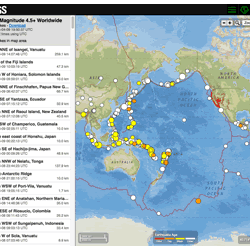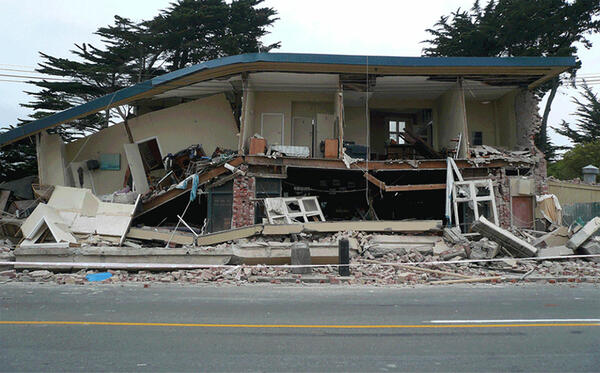Building damanged by the February 2011 earthquake in Christchurch, New Zealand.
Did I feel an earthquake? Can I report feeling an earthquake?
Report an earthquake experience or related observation through the Did You Feel It? citizen science webpage.
The best way to do this is to click on the earthquake that you think you felt on one of the lists on the Earthquakes webpage, and then select the "Tell Us!" link.
If you don't see the earthquake you think you felt, use the green "Report an Unknown Event" button on our Did You Feel It? page. Maps and graphs are produced from the responses in real-time.
Related
Where can I find current earthquake lists and maps for the world or for a specific area?
Why is the earthquake that was reported/recorded by network X, or that I felt, not on the Latest Earthquakes map/list?
Why do some earthquakes disappear from the map/list?
Why isn't the fault on which the earthquake occurred or the distance to the nearest fault provided?
Can I get on a list to receive an email message when there is an earthquake? How do I sign up for earthquake notifications? Are there any Feeds I can subscribe to?
Why/When does the USGS update the magnitude of an earthquake?
Why do so many earthquakes occur at a depth of 10km?
How quickly is earthquake information posted to the USGS website and sent out via the Earthquake Notification Service (ENS) and other feeds?
Where can I see current or past seismograms?
Why do USGS earthquake magnitudes differ from those published by other agencies?
What is UTC, and why do you report earthquakes in UTC?
Building damanged by the February 2011 earthquake in Christchurch, New Zealand.

A map of ShakeOut scenario shaking in southern California.
A map of ShakeOut scenario shaking in southern California.
Starting next Wednesday, July 30, CoreFacts will be delivered once a week instead of daily, in order to bring you better content. Please let us know how you feel about CoreFacts via an e-mail to corecast@usgs.gov. Listen to hear the answer.
Starting next Wednesday, July 30, CoreFacts will be delivered once a week instead of daily, in order to bring you better content. Please let us know how you feel about CoreFacts via an e-mail to corecast@usgs.gov. Listen to hear the answer.
Earthquake information products and tools from the Advanced National Seismic System (ANSS)
United States Geological Survey (USGS) Natural Hazards Response
Earthquake hazards: A national threat
ANSS-Advanced National Seismic System
USGS National Seismic Hazard Maps
NEIC; the National Earthquake Information Center
Related
Where can I find current earthquake lists and maps for the world or for a specific area?
Why is the earthquake that was reported/recorded by network X, or that I felt, not on the Latest Earthquakes map/list?
Why do some earthquakes disappear from the map/list?
Why isn't the fault on which the earthquake occurred or the distance to the nearest fault provided?
Can I get on a list to receive an email message when there is an earthquake? How do I sign up for earthquake notifications? Are there any Feeds I can subscribe to?
Why/When does the USGS update the magnitude of an earthquake?
Why do so many earthquakes occur at a depth of 10km?
How quickly is earthquake information posted to the USGS website and sent out via the Earthquake Notification Service (ENS) and other feeds?
Where can I see current or past seismograms?
Why do USGS earthquake magnitudes differ from those published by other agencies?
What is UTC, and why do you report earthquakes in UTC?
Building damanged by the February 2011 earthquake in Christchurch, New Zealand.
Building damanged by the February 2011 earthquake in Christchurch, New Zealand.

A map of ShakeOut scenario shaking in southern California.
A map of ShakeOut scenario shaking in southern California.
Starting next Wednesday, July 30, CoreFacts will be delivered once a week instead of daily, in order to bring you better content. Please let us know how you feel about CoreFacts via an e-mail to corecast@usgs.gov. Listen to hear the answer.
Starting next Wednesday, July 30, CoreFacts will be delivered once a week instead of daily, in order to bring you better content. Please let us know how you feel about CoreFacts via an e-mail to corecast@usgs.gov. Listen to hear the answer.














